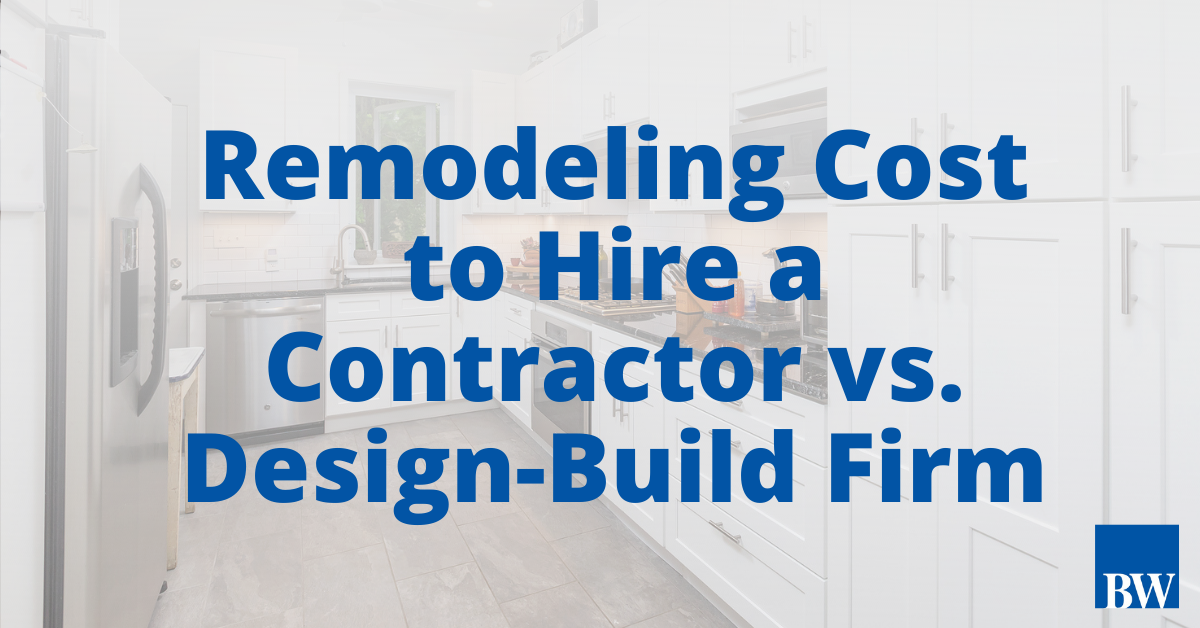
What Will a Remodel Cost if I Hire a Contractor vs. Design-Build firm?
There are so many questions homeowners want to ask when they are contemplating a remodeling project. It can feel like an overload even before you pick out your faucets.
Often, we meet our clients when they are struggling with a decision between moving their family and changing their current home so that it works. “How do I find the right contractor?” is a common question that we can address here. A similar question comes from new home buyers who need to know whether they will be able to afford the necessary improvements in order to update a house they wish to purchase.
In either case, we have the same answers. As with any of our clients, I will try to help you by opening you up to options and sharing information. From a service standpoint, it’s helpful to think about home remodeling in tiers of providers, dictated by the complexity of the project. In busy areas like Philadelphia and the Main Line suburbs, we have the benefit of a full range of providers who can be broken down into 3 tiers: specialty contractors, general contractors, and design-build firms. I will do my best to show you how to approach your remodeling project by raising some questions and answers. When you are finished reading, please ask us for any clarifications in the comment field at the end.
Which Home Improvement Provider Should You Hire?
Before you begin vetting service providers (I wrote an article here that may be helpful) you should consider what level of service your project requires. At Bellweather, we receive many calls from homeowners who believe that they need remodeling management services when all they really need is a responsible and communicative trade specialist (this can be challenging, I realize). Most homeowners are familiar with this first option; a simple repair or replacement gets completed by a specialty trade (sometimes called a ‘subcontractor’) without any professional supervision. Examples include plumbers, electricians, or roofers working with a homeowner under presumably clear and defined goals. Hiring a specialty trade directly is the least expensive since the work required is fully within their skill set.
How to Choose a General Contractor
When projects become more complex, a “general contractor” is the second tier which invites a range of capabilities and costs. A “general contractor” or GC performs the professional supervision necessary to coordinate multiple specialty contractors. With some exceptions, they typically will not be capable of involved design planning and will often collaborate with a designer on larger projects. General contractors may operate under names such as “builder,” “construction,” “remodeler,” or sometimes “carpentry.” The GC usually orchestrates multiple trades when the scope of work is complex, like a bathroom replacement or changing out kitchen cabinetry. A GC may occasionally specialize in some area like basements or more often they are willing to handle a wide range of projects. Similarly, some GC’s prefer smaller projects with fewer selections with less design planning but most are happy to take on something larger with an addition or structural work involved. They will normally either partner with a designer/Architect or ask you to find someone.
You may occasionally find a ‘jack of all trades' where one person (ideally a seasoned veteran) can perform some combination of specialty services and manage themselves with an assistant, completing minor kitchen and bath upgrades. In this scenario, success becomes unlikely on any larger projects since they are neither trained nor licensed to perform specialties and may not be aware of all code requirements.
Separating Design from Build is Expensive
One big problem with hiring separately for designing and building is that the designer or architect has the opportunity to create without the guidance of budgeting information to adjust the scope of work and direct the design solutions. This will either add to the construction costs or add to the design fees after budget checks and revisions. I have never had an architect accurately estimate the cost of a project in design. Very often, a client who has been quite happy throughout design gets upset when the project is priced with various contractors only to find that the costs are far higher than expected. The problem is that although the general contractor may have valuable feedback to contribute to improve the design and reduce costs, there is no opportunity to share those ideas. The contractor is instead asked to price the project as drawn for no cost. To add to the problem, the cheapest contractor gets the project. Clearly, not a model for success.
Not surprisingly, only a portion of architects’ designs is built due to this lack of cost recognition within the design process. Seasoned architects are sometimes better at confirming their early budget assumptions but not always. A growing trend, recognized by both clients and architects, has been toward early collaboration with a reputable design-build firm to make sure that someone on the team can deliver cost-saving solutions and accurate final budgeting.
Why Work with a Design-Build Remodeler?
In full disclosure, I do happen to own a design-build remodeling company and so I may be knowledgeable (a seasoned veteran) but still biased. In the distant past, I have served as a specialty contractor (performing stained glass restoration, painting, and finish carpentry work) and until ten years ago Bellweather was a remodeling contractor without a design department. As we grew the business, I was attracted to the potential for combining my interests in construction problem solving, high-quality design creativity, budgeting, energy efficiency, and timeline control. We had watched many homeowners struggling to coordinate architects, zoning lawyers, engineers, interior designers, cabinet designers, and multiple contractors because they were not shown any other option. Did I mention that I also like systems and teamwork?
Design-build remodeling brings multiple functions under one roof with the potential to provide a continuous service delivery that truly delivers the best experience for a homeowner. In contrast to the dis-coordination model of architect vs. contractor, the design-build remodeling approach revives the tradition of the master-builder where a single firm performs all services. In Colonial America, a master builder might work with a homeowner collaboratively to develop a significant home improvement. The master-builder developed the designs, selected the materials, and ensured quality at each stage of the process. They brought an intimate knowledge of materials, directed the work, and even participated in the labor. At every step of the process, the master-builder knew what things would cost because they did everything.
You Need a Client-Focused Solution
When a well-developed pre-construction process is followed and managed correctly, the design-build approach will result in a high level of project success and (no surprise) client satisfaction. Major renovations and home additions can be hard to plan and execute correctly without a holistic process. Architects, engineers, designers, contractors, and homeowners are eventually at odds if all stakeholders do not follow the same system, working together on a common set of guidelines that focus on project planning and client experience. This is not to imply that architects, engineers, and designers are not required - they are, but the leadership and processes of a good design-build firm bring all stakeholders together under the same set of operating rules.
Asking a client to act as a conduit or interpreter between the architect and the builder is usually a terrible idea and can be very stressful for everyone. As I understand it, architects are professionally barred from managing the builder but the builder can easily hire an architect. We do it all the time. In other situations, we are invited to coordinate a relationship with the client and architect after the design has progressed to the point of needing feedback on project costs before the permit application. Generally, we will then take over the design and the architect steps down. This is also unfortunate because the client experiences a disruption of service and the project loses some creative guidance. In contrast, design-build supports a valuable, collaborative, and continuous team approach. A single team takes responsibility and guides the project through the process from concept to design and straight through to the finish.
Why Work with a General Contractor?
General contractors can be a good option if they are thoughtful and committed to the quality, design, and planning, or pre-construction process. This will obviously only happen when the homeowner intentionally searches for this talent. Collaborative design development with a contractor of this caliber can be very successful and can be teamed up with an equally thoughtful architect or design firm. The best practice for cost control dictates that you ask for a ‘fixed price contract’. There should be very few unforeseen discoveries during construction that require change orders, usually, no more than 5% if the planning was done correctly. It is appropriate to ask plenty of questions about cost and timeline commitments. There is no reason to have vague or verbal hopes or expectations, so get it all in writing. I think there is an unspoken fear that contractors will take advantage of homeowners and so they need to be kept under control. This attitude is a shame but it is up to everyone to confirm the goals of teamwork, trust, and integrity and there is no reason that you as a client can’t lead this charge on your own project.
Sending Your Design out to Bid: Losing Control
In the typical situation where an architect or designer sends out plans to multiple contractors to bid, alignment with quality, design, and planning is unlikely. Regardless of how you make your decision in a bid situation, you have invested so much of your time and energy into the design and finish selection process. Now you are creating a disconnect between design and construction. You have achieved a false sense of cost control but your new contractor has not taken the time to fully understand the project without getting paid for this crucial service. Once they ‘win’ the bid to build your project, they will determine how to make that missing money back, either by cutting corners or by charging plenty of change orders for ‘unforeseen’ conditions. Either option creates stress for everyone and reduces the quality of the project.
Pre-Construction Planning, Timing and Project Cost
You have a big up-front responsibility. Remodeling any part of your house is a big deal and needs your careful selection of a contractor, designer, or design builder. Be sure to take the time needed to find a provider with a high degree of trust, integrity, and teamwork. Make sure that they are committed to working together on planning with you. Design isn’t the only type of preparation required before starting a project and no project that benefits from a fast start. If starting construction ASAP is your mandate then get ready for disappointment. No one can avoid mistakes without pre-construction planning. Too many mistakes being solved results in stress, design changes, higher costs, and schedule overruns.
Holding down costs is a crucial phase of planning. If you have a tight budget then all the more reason to choose a provider that will present you with cost options during design. Make sure that you set time aside to ask plenty of questions and to weigh the pros and cons of the design direction. It’s very tempting to forego the lengthy planning approach and creatively design 'on the fly' as you build, but trust me: only amateurs make design decisions while they build.
Written by Will Giesey
How Much Does a Kitchen Remodel Cost in Philadelphia?
A kitchen remodel is truly the most effective catalyst for improving how your family functions...
7 Items to Consider When Choosing a Home Remodeling Contractor
Regardless of where you call home, my goal is to improve your remodeling success story by sharing...
5 Indications That Your Remodeling Project is a Good Fit for Design-Build
What is Design-Build? You may have heard of the term “design-build”, but what is it, exactly?...



